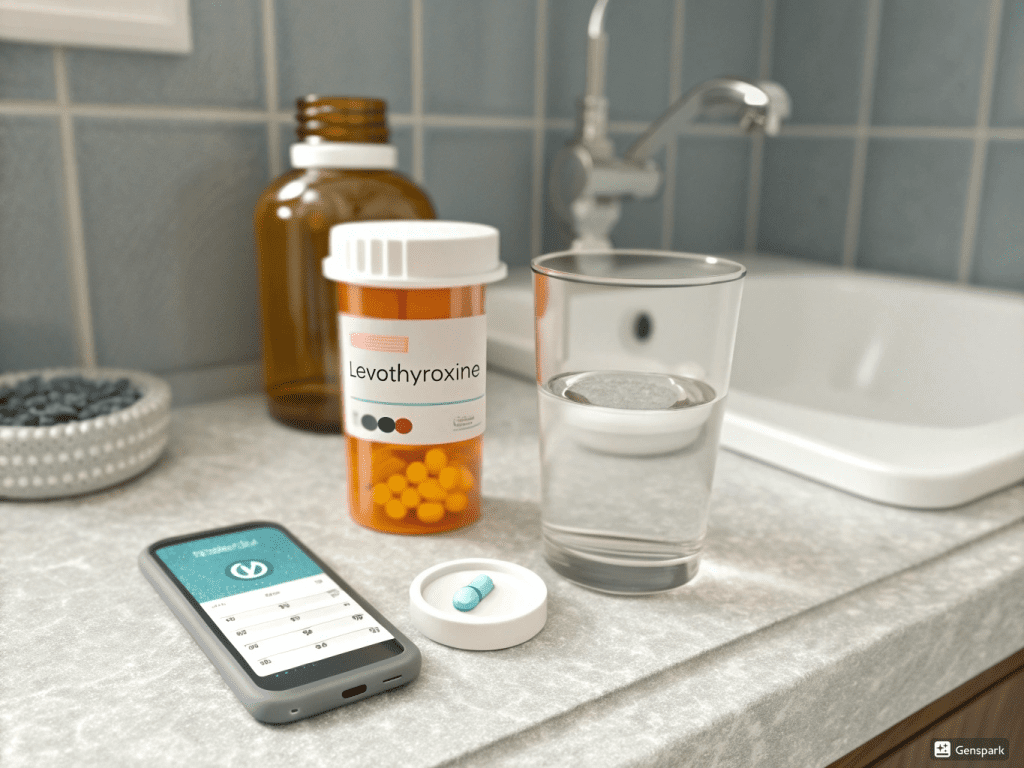If you’re managing hypothyroidism and taking both levothyroxine and iron supplements, timing is everything. Taking them too close together can reduce your thyroid med absorption, leading to fluctuating hormone levels and stubborn symptoms. This expert-backed guide explains the iron and levothyroxine interaction, why spacing matters, and how to safely schedule both for optimal thyroid health.
You’ll also learn the science behind the interference, get practical timing tips, and discover newer medication options that could make your routine easier.
Summary: When to Take Iron and Levothyroxine
| Medication | When to Take | Wait Before Taking Iron |
|---|---|---|
| Levothyroxine | On an empty stomach — 60 minutes before breakfast or 3+ hours after dinner | Wait at least 4 hours before iron |
| Iron Supplements | With food if tolerated | Take 4 hours after levothyroxine |
- Do not take levothyroxine and iron together — iron can significantly block absorption.
- Most experts, including the American Thyroid Association, recommend a 4-hour gap.
- Improper spacing can raise TSH levels and worsen hypothyroid symptoms.
- New liquid or soft-gel thyroid meds may reduce absorption issues, but spacing is still best practice.
Why Timing Between Iron and Thyroid Medication Is Critical

Taking your thyroid meds and iron together might seem harmless — but it’s one of the most common supplement-drug interactions affecting people with hypothyroidism. Research consistently shows that iron binds to levothyroxine in the gut, preventing it from being absorbed effectively into the bloodstream.
How This Interaction Happens
Iron and levothyroxine form insoluble complexes in your digestive tract, rendering the thyroid medication much less effective. According to a detailed overview from the American Thyroid Association, this interference is especially pronounced with iron sulfate or multivitamins containing iron.
What’s at Risk?
Here’s what can happen if the timing isn’t spaced out properly:
- Reduced levothyroxine absorption, leading to lower hormone levels
- Elevated TSH levels, despite consistent medication use
- Worsening symptoms like fatigue, depression, constipation, and sensitivity to cold
- Increased levothyroxine dosage requirements, especially during pregnancy or iron supplementation
A study in Endocrine Abstracts found that pregnant women taking iron needed up to 40% more levothyroxine to maintain proper thyroid levels.
Optimal Spacing: How Long to Wait Between Iron and Levothyroxine
The gold standard recommendation is a 4-hour separation between taking levothyroxine and any supplement or medication containing iron. This guideline is echoed across major clinical resources, including Drugs.com and Mayo Clinic.
Is 2 Hours Enough?
Some smaller studies, like those reviewed in Verywell Health, suggest that 2 hours may partially reduce the interaction, but it doesn’t fully eliminate it. For safety and consistency, a minimum of 4 hours is ideal — especially for those with persistent symptoms or thyroid instability.
Daily Scheduling Tips
| Time of Day | Levothyroxine | Iron Supplement |
|---|---|---|
| Morning | 7:00 AM (empty stomach) | 11:00 AM (with light snack) |
| Evening | 9:00 PM (3 hrs after dinner) | 5:00 PM (afternoon with food) |
You can also try setting reminders or using a pill organizer with color-coded compartments. For additional interaction management tips, see our article on probiotics and antibiotic timing guidelines.
Clinical Consequences of Poor Timing
Improper spacing isn’t just inconvenient — it’s clinically significant.
- A 2021 review in Pharmaceuticals found that up to 67% of patients took levothyroxine within 1 hour of iron or calcium supplements, leading to unstable hormone levels.
- Patients may need higher medication doses unnecessarily, which can increase side effects.
- In some cases, doctors may mistakenly adjust your thyroid dose when the real issue is poor absorption due to interactions.
Symptoms of Malabsorption
If you’ve been following your prescribed dose but still feel off, consider whether iron or other supplements might be interfering. Signs include:
- Return of hypothyroid symptoms
- Unexpected weight gain
- Feeling cold or sluggish despite normal labs
- Slow improvement after dose changes
If you’re also taking calcium, antacids, or multivitamins, you might be interested in how calcium supplements can affect other meds like antibiotics.
Improving Absorption: New Thyroid Medications That May Help
For patients who struggle to time their meds consistently, newer levothyroxine formulations may reduce absorption issues. These include:
1. Liquid Levothyroxine
Studies from PubMed Central show that liquid forms bypass some food and supplement-related absorption issues, making them more forgiving with timing.
2. Soft-Gel Capsules
Brands like Tirosint® offer soft-gel capsules that dissolve differently in the GI tract, potentially improving consistency — though the 4-hour spacing rule still applies for maximum absorption.
Still unsure? Consult with your doctor before switching formulations. Always remember: the goal is consistent, effective hormone absorption, not just convenience.
Best Practices for Levothyroxine and Iron Supplement Timing
To make your routine easier and safer, follow these proven guidelines:
Levothyroxine Timing Rules
- Take on an empty stomach, at least 60 minutes before food
- Best taken first thing in the morning or at bedtime
- Avoid taking with coffee, soy, or high-fiber foods
Iron Supplement Timing Tips
- Take with vitamin C or orange juice to enhance absorption
- If it upsets your stomach, take with a small meal — but never alongside thyroid meds
- Consider a mid-morning or late afternoon slot, depending on your levothyroxine timing
Need help managing other supplement-med combos? Read our article on magnesium and blood pressure medications for timing best practices.
Final Thoughts: Timing Is the Key to Thyroid Medication Success
The iron and levothyroxine interaction is one of the most overlooked yet impactful factors in thyroid treatment. By keeping a simple 4-hour buffer, you can dramatically improve thyroid med absorption and feel more in control of your health.
Whether you’re newly diagnosed or adjusting your supplement routine, don’t underestimate the power of timing. Talk to your provider about newer levothyroxine options if consistency is a challenge — and always double-check your supplement list.
Explore more at UsefulVitamins, including how joint pain from calcium supplements and steroids might signal deeper nutrient conflicts.

